Top Rankings
Dyrs School District ranks among the top 20% of public school district in Maryland for:
Category
Attribute
Science Proficiency
Highest science proficiency (Top 10%)
Student Attention
Lowest student:teacher ratio (Top 1%)
For the 2025 school year, there are 2 public schools serving 36 students in Dyrs School District.
Public Schools in Dyrs School District have a diversity score of 0.11, which is less than the Maryland public school average of 0.74.
Minority enrollment is 100% of the student body (majority Black), which is more than the Maryland public school average of 68% (majority Black).
Overview
This School District
This State (MD)
# Schools
1 School
1,413 Schools
# Students
36 Students
890,455 Students
# Teachers
10 Teachers
61,620 Teachers
Student : Teacher Ratio
4:1
4:1
District Rank
Overall District Rank
#40 out of 57 school districts
(Bottom 50%)
(Bottom 50%)
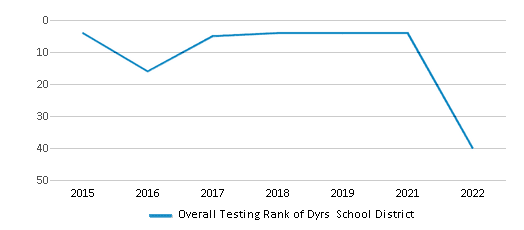
Math Test Scores (% Proficient)
≤10%
25%
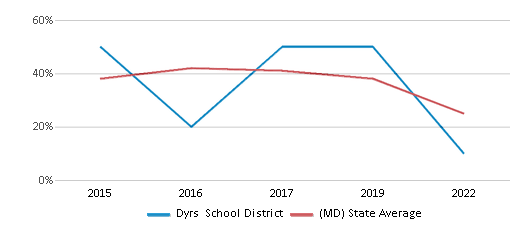
Reading/Language Arts Test Scores (% Proficient)
≤10%
45%
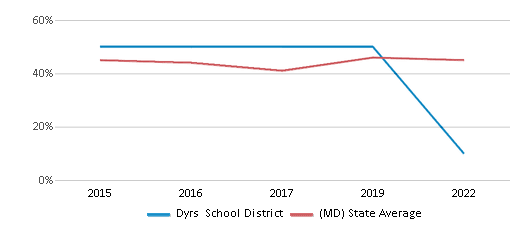
Science Test Scores (% Proficient)
<50%
36%
Students by Ethnicity:
Diversity Score
0.11
0.74
# American Indian Students
n/a
2,391 Students
% American Indian Students
n/a
n/a
# Asian Students
n/a
60,213 Students
% Asian Students
n/a
7%
# Hispanic Students
2 Students
202,727 Students
% Hispanic Students
6%
23%
# Black Students
34 Students
288,848 Students
% Black Students
94%
33%
# White Students
n/a
286,955 Students
% White Students
n/a
32%
# Hawaiian Students
n/a
1,211 Students
% Hawaiian Students
n/a
n/a
# Two or more races Students
n/a
47,519 Students
% of Two or more races Students
n/a
5%
Students by Grade:
# Students in PK Grade:
-
31,381
# Students in K Grade:
-
60,579
# Students in 1st Grade:
-
63,130
# Students in 2nd Grade:
-
65,933
# Students in 3rd Grade:
-
64,137
# Students in 4th Grade:
-
65,488
# Students in 5th Grade:
-
65,328
# Students in 6th Grade:
-
64,624
# Students in 7th Grade:
-
65,549
# Students in 8th Grade:
1
65,988
# Students in 9th Grade:
11
79,802
# Students in 10th Grade:
17
72,380
# Students in 11th Grade:
7
64,963
# Students in 12th Grade:
-
61,173
# Ungraded Students:
-
-
District Revenue and Spending
Total Revenue
$4 MM
$17,412 MM
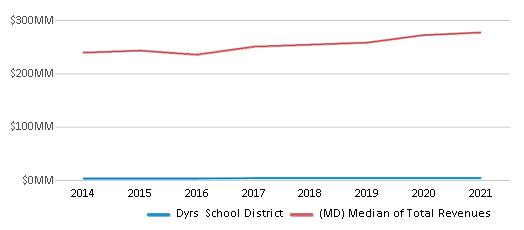
Spending
$3 MM
$16,456 MM
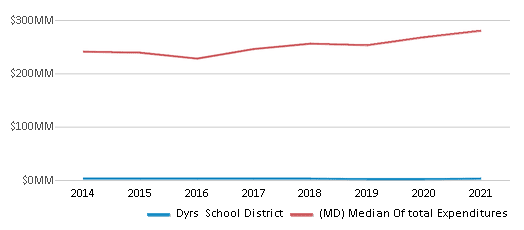
Revenue / Student (13-14)
$59,981
$15,123
Spending / Student (13-14)
$60,906
$15,201
Best Dyrs School District Public Schools (2025)
School
(Math and Reading Proficiency)
(Math and Reading Proficiency)
Location
Grades
Students
Rank: #11.
Maya Angelou Academy At New Beginnings Formerly Oak Hill
Alternative School
(Math: <50% | Reading: ≤20%)
Rank:
Rank:
8/
Top 30%10
8400 River Rd
Laurel, MD 20724
(202) 299-3227
Laurel, MD 20724
(202) 299-3227
Grades: 7-12
| 36 students
Rank: #22.
Maya Angelou Academy At Youth Services Center
Alternative School
(Math: ≤20% | Reading: ≤20%)
Rank:
Rank:
6/
Top 50%10
1000 Mount Olivet Road Ne
Washington, DC 20002
(202) 202-7007
Washington, DC 20002
(202) 202-7007
Grades: 6-12
| n/a students
Frequently Asked Questions
How many schools belong to Dyrs School District?
Dyrs School District manages 2 public schools serving 36 students.
What is the racial composition of students in Dyrs School District?
94% of Dyrs School District students are Black, and 6% of students are Hispanic.
What is the student/teacher ratio of Dyrs School District?
Dyrs School District has a student/teacher ratio of 4:1, which is lower than the Maryland state average of 15:1.
Recent Articles

Year-Round Or Traditional Schedule?
Which is more appropriate for your child? A year-round attendance schedule or traditional schedule? We look at the pros and cons.

Why You Should Encourage Your Child to Join a Sports Team
Participating in team sports has a great many benefits for children, there is no doubt. In this article you will learn what those benefits are.

White Students are Now the Minority in U.S. Public Schools
Increasing birth rates among immigrant families from Asia and Central and South America, combined with lower birth rates among white families, means that for the first time in history, public school students in the United States are majority-minority. This shift in demographics poses difficulties for schools as they work to accommodate children of varying language abilities and socio-economic backgrounds.





